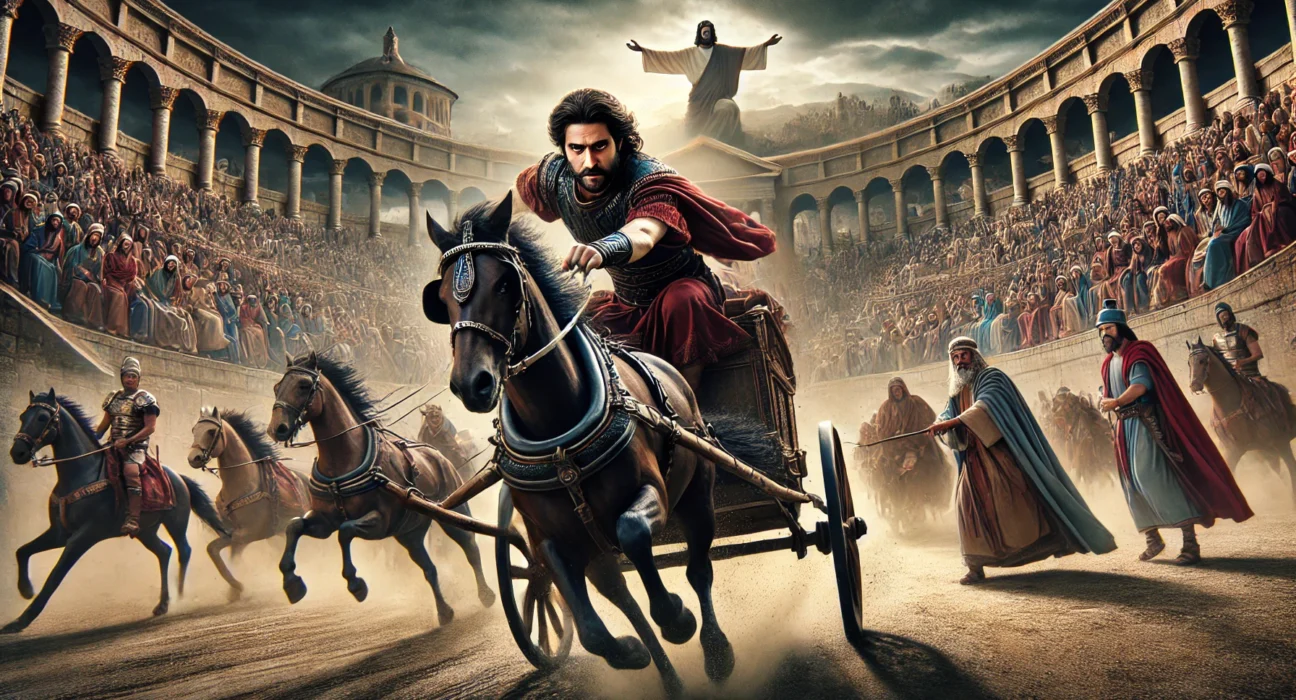“Ben-Hur: A Tale of the Christ” by Lew Wallace, first published in 1880, is a monumental work of historical fiction. Set in ancient Judea, the story intertwines the life of Judah Ben-Hur, a Jewish prince wrongfully enslaved by the Romans, with key moments from the life of Jesus Christ. This narrative follows Ben-Hur’s quest for vengeance, redemption, and spiritual awakening, framed against the backdrop of Roman oppression, Jewish unrest, and the dawn of Christianity. The novel was immensely popular in its time and remains significant as a historical epic exploring themes of faith, forgiveness, and salvation.
Plot Summary
On a bright day in Jerusalem, Judah Ben-Hur, a young Jewish nobleman, crosses paths with his childhood friend, Messala, who has returned from years in Rome. Once close, their reunion reveals a bitter divide. Messala, now a Roman officer, has embraced the Empire’s ruthless power, while Ben-Hur remains loyal to his Jewish heritage. The tension between them quickly escalates when Judah refuses to support Messala’s Roman ambitions. Betrayal follows swiftly.
During a parade honoring the new Roman governor, Valerius Gratus, an accident occurs. A loose tile falls from the roof of Ben-Hur’s house, striking the governor. Though an accident, Messala seizes the opportunity to destroy his former friend. Judah is falsely accused of attempted assassination, his family imprisoned, and all his wealth confiscated. He is sent into slavery, chained to the oars of a Roman warship. As he is torn from his family, his heart hardens with a desire for revenge against Messala.
For years, Ben-Hur toils as a galley slave, enduring the brutality of the sea and the cruelty of the Romans. His thoughts dwell on vengeance, but fate has other plans. During a fierce naval battle, Judah saves the life of a Roman officer, Quintus Arrius. In gratitude, Arrius takes Judah under his protection, eventually adopting him as his son. Now a free man and a skilled athlete, Ben-Hur inherits Arrius’ wealth and status, but the thirst for revenge still burns within him.
In his quest for retribution, Judah travels to Antioch, where he meets Sheik Ilderim, a wealthy Arab who owns a team of powerful horses. Ilderim, a shrewd and generous man, quickly realizes Ben-Hur’s potential as a charioteer and offers him a chance to compete in a grand race against none other than Messala, now a celebrated Roman racer. The stakes are high, not just for the prize, but for Judah’s long-awaited revenge.
Meanwhile, Judah’s journey leads him to Simonides, once a loyal servant of the Hur family. Simonides, now a wealthy and influential merchant, reveals that he has secretly safeguarded the family fortune. Judah also learns that his mother and sister, believed dead, have been imprisoned in a Roman dungeon for years, left to suffer in squalor and disease. Heartbroken, Judah is further devastated when he discovers they have contracted leprosy. They refuse to meet him, fearing their illness will bring shame upon him. Consumed by grief and anger, Judah’s desire for vengeance intensifies.
The fateful chariot race arrives, drawing vast crowds to the arena. Ben-Hur, now a formidable opponent, faces Messala in the race that will decide their fates. The tension in the air is palpable as the race begins, and the two rivals push their horses to the limit. Messala, confident and ruthless, attempts to destroy Judah’s chariot, but in a dramatic turn, his own hubris leads to his downfall. Messala’s chariot crashes violently, leaving him severely injured and broken in both body and spirit. Judah emerges victorious, but instead of the satisfaction he had expected, he is left with a hollow sense of triumph.
Even as Messala lies defeated, Judah’s heart remains conflicted. His revenge has been achieved, yet it brings no peace. His mother and sister remain isolated in their leper colony, and the suffering of his people under Roman rule weighs heavily on him. Despite his wealth and status, Judah feels lost, seeking something greater to fill the emptiness within.
Amidst this turmoil, news spreads of a man called Jesus of Nazareth, a teacher and healer who preaches a message of love and forgiveness. Judah recalls a moment from his past, when he was a slave being marched through Nazareth. A man had given him water and comfort, a gesture that had touched him deeply in a moment of despair. That man was Jesus. Intrigued by the rumors and longing for hope, Judah seeks out this prophet, though he remains skeptical of any power greater than revenge.
The final moments of the narrative converge at the crucifixion of Jesus. Judah witnesses the trial and eventual execution of the man who had once shown him kindness. As Jesus is led to his death, Judah is overwhelmed by the calm dignity and compassion Jesus exhibits even toward his tormentors. When Jesus utters a prayer of forgiveness for those who are killing him, something within Judah changes. The weight of his hatred and desire for vengeance begins to lift, replaced by a profound sense of peace.
In the aftermath, Judah’s mother and sister are miraculously healed of their leprosy. The joy of their reunion is heightened by the realization that forgiveness and love, the very things Jesus preached, are more powerful than hatred and revenge. Judah’s heart, once hardened by the injustices he endured, is softened by the example of Christ’s selflessness.
Now free from the chains of vengeance, Judah Ben-Hur embraces the faith that has spread through the land. He dedicates himself to living by the principles of love, forgiveness, and compassion, becoming a symbol of redemption for his family and his people. Through his journey, he discovers that true victory lies not in defeating one’s enemies, but in embracing the spirit of forgiveness and finding peace within.
Main Characters
Judah Ben-Hur: The protagonist, Judah is a nobleman from Jerusalem who is betrayed by his Roman childhood friend, Messala, and sold into slavery. Over the course of the novel, Ben-Hur evolves from a man consumed by thoughts of revenge to one who embraces forgiveness and faith, paralleling the teachings of Christ.
Messala: Once a friend of Ben-Hur, Messala becomes his enemy after aligning with the Roman Empire. His ambition, cruelty, and betrayal drive much of Ben-Hur’s early quest for vengeance.
Esther: The daughter of Simonides, a loyal servant to Ben-Hur’s family. Esther grows to become Judah’s love interest. She is characterized by her quiet strength, compassion, and deep faith.
Simonides: A slave who becomes a prosperous merchant, Simonides remains fiercely loyal to Ben-Hur’s family despite his servitude. His wisdom and devotion aid Judah in his journey.
Sheik Ilderim: A wealthy Arab who becomes an ally to Ben-Hur, helping him prepare for the famous chariot race. He symbolizes generosity and loyalty.
Tirzah: Ben-Hur’s sister, who, along with their mother, is imprisoned for years in a Roman dungeon due to Messala’s betrayal. Her suffering represents the broader oppression of the Jewish people under Roman rule.
Jesus Christ: Though a minor character in terms of direct interaction, Christ’s presence is central to the novel’s themes. His brief encounters with Ben-Hur, particularly His act of giving water to the enslaved Judah, are pivotal moments that lead Ben-Hur toward spiritual enlightenment.
Theme
Revenge and Redemption: One of the novel’s central themes is Ben-Hur’s journey from a thirst for vengeance against Messala to the eventual realization that forgiveness and love, as taught by Christ, offer true redemption. This shift mirrors the transformative power of faith.
Faith and Salvation: The life and teachings of Jesus Christ provide a moral and spiritual framework for the narrative. Ben-Hur’s evolving faith reflects the broader spread of Christianity in a world ruled by violence and injustice.
Slavery and Freedom: The novel explores literal and metaphorical bondage. Ben-Hur’s enslavement is paralleled with the spiritual enslavement of many characters to anger, revenge, or material wealth, and contrasts with the freedom found through faith in God.
Family and Loyalty: Ben-Hur’s loyalty to his family, and their suffering under Roman oppression, drives much of his early motivations. The rediscovery of his mother and sister, coupled with their suffering, provides a powerful emotional undercurrent to the story.
The Clash of Cultures: The novel portrays the tension between the Jewish people and their Roman oppressors. Through characters like Messala, the novel explores how power corrupts and how differing values—honor, loyalty, faith—clash in a period of great upheaval.
Writing Style and Tone
Lew Wallace’s writing in Ben-Hur is lush, detailed, and imbued with a sense of grandeur. His descriptive passages are often panoramic, especially when detailing historical or religious settings. Wallace immerses the reader in the ancient world of Judea and Rome, using elaborate descriptions to evoke the physical and spiritual landscapes of the time. This expansive narrative style gives the novel an epic scope, making it more than just an adventure story but a spiritual odyssey.
Wallace balances action-packed sequences—such as the famous chariot race—with quiet, introspective moments, particularly when Ben-Hur wrestles with his faith and morality. His tone is often reverent, particularly in scenes involving Jesus Christ, which are handled with a sense of awe and sanctity. This contrasts with the more brutal depictions of Roman cruelty and the raw emotions tied to Ben-Hur’s quest for revenge. Wallace’s tone elevates the novel beyond mere historical fiction, casting it as a moral and religious parable.
We hope this summary has sparked your interest and would appreciate you following Celsius 233 on social media:
There’s a treasure trove of other fascinating book summaries waiting for you. Check out our collection of stories that inspire, thrill, and provoke thought, just like this one by checking out the Book Shelf or the Library
Remember, while our summaries capture the essence, they can never replace the full experience of reading the book. If this summary intrigued you, consider diving into the complete story – buy the book and immerse yourself in the author’s original work.
If you want to request a book summary, click here.
When Saurabh is not working/watching football/reading books/traveling, you can reach him via Twitter/X, LinkedIn, or Threads
Restart reading!








